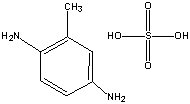
NTP Study Reports

NTP Study Reports
Home » Study Results & Research Projects » NTP Study Reports » All Long-Term Reports » Abstract for TR-126 - 2,5-Toluenediamine Sulfate

| Chemical Formula: C7H10N2 · H2SO4 | - | 3D Structure* | |
|---|---|---|---|
| *To view structure, download free Chemscape Chime Plug-in | |||
2,5-Toluenediamine sulfate, a salt of 2,5-toluenediamine and sulfuric acid, was selected for bioassay by the National Cancer Institute in an attempt to determine those dye intermediates which may be responsible for the increased incidence of bladder cancer observed among workers in the dye manufacturing industry. Aromatic amines are one of several classes of chemicals thought to contribute to the increased cancer risk in this industry.
A bioassay for possible carcinogenicity of 2,5-toluenediamine sulfate was conducted using Fischer 344 rats and B6C3F1 mice. 2,5-Toluenediamine sulfate was administered in the feed, at either of two concentrations, to groups of 50 males and 50 females of each species. The high and low time-weighted average concentrations of the compound were, respectively, 0.2 and 0.06 percent for rats and 0.1 and 0.6 percent for mice. Because compound administration to the high and low dose groups of each species was not begun simultaneously, each dosed group was assigned a control group. All control groups consisted of 50 animals, except for the high dose male and female rat control groups which were composed of 25 animals. The dosing period was for 78 weeks, followed by an additional 28 to 31 weeks of observation in rats and an additional 16 to 19 weeks in mice.
There was no significant association between compound administration and accelerated mortality in either sex of either species. Adequate numbers of animals in all groups survived sufficiently long to be at risk from late-developing tumors.
A statistically significant incidence of interstitial-cell neoplasms of the testis in dosed male rats was not considered attributable to administration of the compound since the spontaneous incidence of these neoplasms in male Fischer 344 rats is both high and variable. No neoplasms were observed in female rats at statistically significant incidences.
A statistically significant increase in lung tumors in high dose female mice was not considered convincing evidence of a compound-related carcinogenic effect because high dose male mice were received in separate shipments from their controls and housed in separate rooms from their controls.
Under the conditions of this bioassay, sufficient evidence was not obtained to demostrate the carcinogenicity of 2,5-toluenediamine sulfate in either Fischer 344 rats or B6C3F1 mice.
| Male Rats: | Negative | |
| Female Rats: | Negative | |
| Male Mice: | Negative | |
| Female Mice: | Negative |
Synonyms: 2-methyl-1,4-benzenediamine sulfate; p-tolylenediamine sulfate; p-diaminotoluene sulfate; Fouramine standard; C.I. Oxidation base 4
Report Date: 1978
Target Organs from 2-year Studies
You may link to the full technical report in pdf format ( Note: A print ready copy of the document is presented in Portable Document Format (pdf) which requires the Acrobat Reader plug-in -- download a free copy of the reader.)
Web page last updated on October 14, 2004
The National Institute of Environmental Health Sciences is one of the National Institutes of Health within the U.S. Department of Health and Human Services. The National Toxicology Program is headquartered on the NIEHS campus in Research Triangle Park, NC.